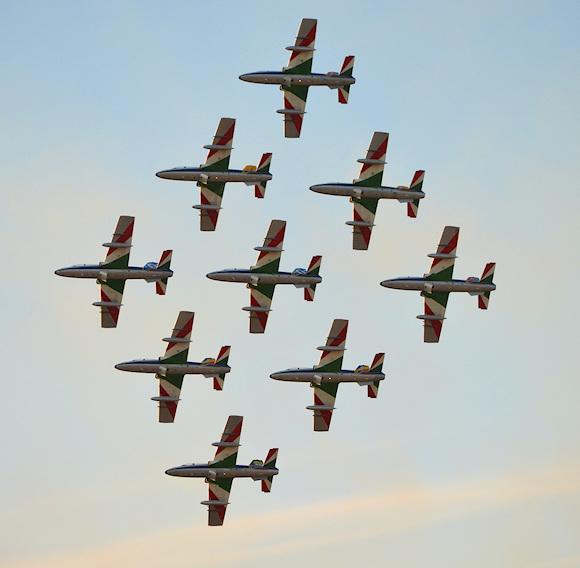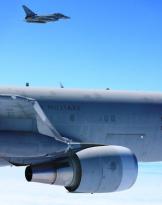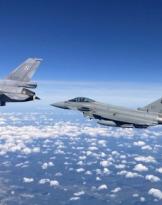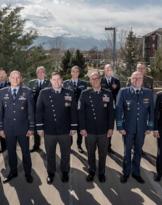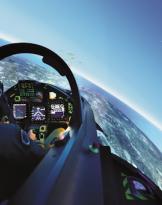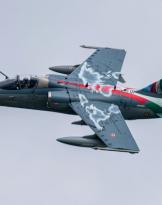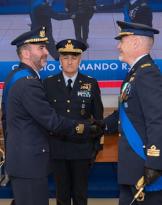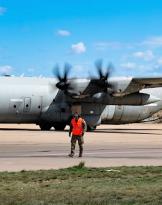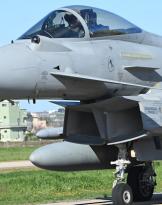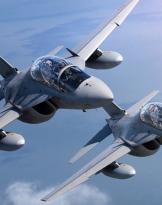When you turn your birthday, it is usually the birthday boy who receives the gifts, but this time the parties have reversed: the birthday of the "Frecce Tricolori" National Acrobatic Team gave us 3 days of respite and healthy (SANA under all points of view, including that of protection from contagion) brain detoxification from the incessant, omnipresent debate on the "green pass" and in our ears only the roar of afterburners and engines entered our ears.
It was not an easy one airshow, in the canonical sense of the term feast of the air, but an opportunity to take stock (and for someone become aware) of the operational progress that the Armed Force has made in recent years, presenting everything in a highly motivational way.
Obviously, there was also the time for the "scenic" exhibition typical of each "airshow" offered some friendly acrobatic patrols who wanted to pay homage to the celebrated: the Orlik acrobatic team (Poland), the "Midnight Hawk" (Finland) , the “Patrulla Aguila” (Spain) and the Patrouille Suisse (obviously Switzerland): the first half of the exhibition was just that. Compared to previous anniversaries, there has been a lack of representative patrols of foreign armed forces, but it will already have been a titanic undertaking to put on a demonstration of this caliber, with all the additional security procedures required by the contemporary situation. And it must be said that this gap has been largely filled with what has been seen in the second part. Certainly the "short" days of mid-September, with certain meteorological worries, was not generous in rewarding the organizational effort made, but in this event we saw something new.

The second part of the day, in fact, was a great opportunity to see a taste of the real operating scenario.

A first demonstration of "scramble" gave a spectacular demonstration of the ability of that complex device that, in a few minutes, ensures the take-off of fighters to intercept and identify any suspicious air tracks detected by the radar: 2 Eurofighers have intercepted and "secured to the ground" (by continuously monitoring the target with spectacular low-altitude circling) an HH-139 helicopter.
Spectacular demonstration, but also highly technical, because it allowed to show with what safety a bi-sonic aircraft can intervene lightning fast and keep under control also targets characterized by low speed, and above all with what ease and safety this interceptor can keep "on the ropes" the target, with maneuvers considered dangerous for the controllability of other aircraft.
In truth, the presentation of the Eurofighter made by the Experimental Department already demonstrates this and more, but a simulation like this one we have witnessed makes the message explicit even to the less technical enthusiast in the audience.
The second aerotactic demonstration, on the other hand, can be considered a significant implementation of what was introduced in 2019, at the time with only AMXs.
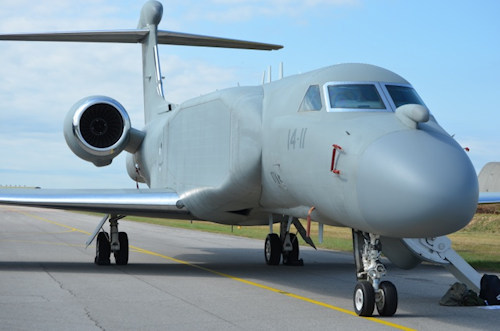 A simulation of a Combat Rescue, Search and Rescue (CSAR) operation of crews or personnel beyond enemy lines was proposed here. Simulation that has completely replaced, integrating with today's operational structure, the usual demonstration of recovery of a castaway with which all aerial demonstrations have always opened.
A simulation of a Combat Rescue, Search and Rescue (CSAR) operation of crews or personnel beyond enemy lines was proposed here. Simulation that has completely replaced, integrating with today's operational structure, the usual demonstration of recovery of a castaway with which all aerial demonstrations have always opened.
There were at the same time in flight (presented to the public on several occasions according to the competence for their role): 2 HH-101 helicopters, 2 AMX, 1 Tornado IT-ECR, 1 KC-767 °, 2 Eurofigher and 1 F35- TO. Invisible to the public, but still in flight, what is probably the most complicated thing: the control room, consisting of 1 MQ-1C “Predator A +” and a Gulfstream “E-500 CAEW”.
The former proved his invisible vigilance by linking his cameras to the monitors of the audience. The second, on the other hand, appeared at the end of the operation, silently waiting for his turn for refueling in flight. But the CAEW with its extraordinary multi-sensor system, provided the “flying command post” of the entire operation, presiding over the functions of air surveillance, electronic countermeasures, and control and communications. A task that is far from simple, when it is necessary to coordinate such a heterogeneous multitude of aerotactic assets, even more so in the real war scenario.
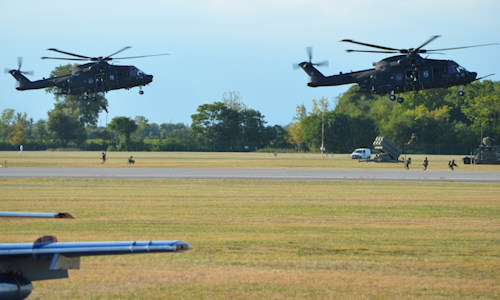
As mentioned, Predator and CAW were practically invisible, but they could be seen calmly and closely in the static exhibition, together with all the means supplied to the Air Force and also with some other jewels of national production, this time able to whiz on asphalt without taking off and with the total cost of some T345…!
Returning to the simulation of the aerotactic operation, two HH-101 helicopters "deposited" in a parallel hovering not easy to perform (given the weight class of the helicopter), two teams of raiders from the 17th wing in the area monitored by the Predator .
The 2 AMX here in Rivolto were equipped with a reconnaissance pod, useful for tactical reconnaissance and aerocooperation with the land and naval surface forces but it is an aircraft that allows the necessary close support (CAS, Close Air Support), while the role of the Tornado IT-ECR (Electronic Combat Reconnaissance) is even heavier: that of the suppression of the opposing air defenses.
All these flight operations then require the logistical support of the tankers, but also the protection of interceptors and here is the turn of the KC-767 ° and C-130 J for a purpose, and of the Eurofigher and the F35-A for the 'other.

The F-35 is in truth by itself a fifth generation weapon system equipped with operational capabilities such as to allow the simultaneous and autonomous carrying out of all missions of the aerotactic doctrine, thanks to its integrated avionics systems that provide the pilot with a complete picture of the battle space, and the use of technologies suitable for low observability. To tell the truth its noise does not exactly go unnoticed but on occasions like these it is only an advantage!
Another type of F35 (version B) dominated the scene in a subsequent context, stopping for a long time in flight to greet the authorities present (President of the Republic, President of the Senate, Minister and Undersecretary of Defense, but also the medal of 'silver in K1 200 meters from the speed canoe at the Tokyo Olympic Games, Manfredi Rizza) to then make the vertical landing, a capacity that together with the short take-off (STOVL - Short Take Off Vertical Landing) makes the difference with version A.
His presentation brought to mind the presentations of the Navy's AV8-Bs, but the two aircraft are very different, and the "technological gap" that separates them is really great. They only have in common the characteristic of being able to be used in contexts where a fighter aircraft would otherwise not be usable, after which the “35-B” is still an F35. It is its propulsion system, together with the flight controls that had to adapt to the architecture of the "conventional" aircraft, while for the AV-8 B (evolution of the more famous "Harrier") the opposite happened, having been built “around” a vectorable multiple thrust turbo fan.
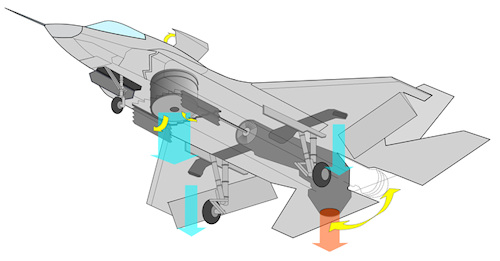
An architecture that allowed something more in stationary or vertical flight, but which penalized the overall performance of the aircraft compared to the F-35B for which the description already made for the F35-A applies.
The "F35-B", on the other hand, has a colossal engine equipped with an exhaust cone that can be oriented downwards if necessary, and a fan driven by the only engine located behind the cockpit that balances the vetical thrust in front of the center of gravity of the aircraft. .
To the "operational" advantage of having unthinkable performance and capacity for the AV-8B, we must add the industrial advantage of being able to synergistically share the same design platform. A huge advantage, from every point of view.
The in-flight presentation of the F-35 certainly captured the attention of every spectator, but it certainly did not detract from the always magnificent presentations of the Experimental Department of Pratica di Mare, which showing the quality of the vehicles supplied to our Air Force , it also exposes the capabilities of our domestic industry, which is good for exports.
A "sentimental" moment of the event had actually already occurred in the passage between the first and second part of the day: the "Legend Formation", which brings together the most significant representatives of the glorious Italian tradition in the training of pilots, from FIAT G46 to T346, hosted the only flying example of Aermacchi MB 326-K, an aircraft never owned by the Italian Air Force, but hundreds of copies exported all over the world.

Obviously in that lineup there were also the MB 339-A and MB339-C, but the most appreciated “339” of the event could only be the celebrated: that of the Frecce Tricolori, in the magnificent livery designed by Mirco Pecorari.
The designer commented on his idea of assigning to the drift of each airplane a reference to a historical patrol prior to the establishment of the Frecce Tricolori: the "Lanceri Neri", the "White Tigers", the "Red Devils", the "Prancing Horses" and “Getti Tonanti”, also explaining the reason for those Olympic rims modified, already in the originals, in the livery of the latter, to indicate the union between the pilots.
And just before the event, just before the event, the joke was intended for the pilots of the current formation, their helmet decorated halfway through the usual paintwork, and half with the color of the "historical" acrobatic team assigned to drift their own. airplane.
Brilliant idea and magnificent result!
It would only remain now to talk about the celebrated, but in all honesty, what can we still add that has not already been said over and over again?
It is always them: the pilots change, it has long been said that they must also change the airplane, but the excellence of the quality of their performance and the ability to flood the heart of every Italian with nationalistic pride has remained unchanged for 60 years.

Photo: Giuseppe Lodi / author

